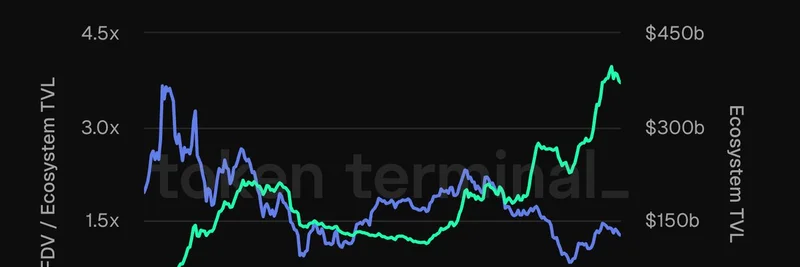Ethereum's ecosystem is showing some serious growth, and if you're into meme tokens or just keeping tabs on the broader crypto space, this is worth paying attention to. A recent chart from Token Terminal highlights how apps built on Ethereum are now hosting more than $370 billion in user assets. That's a massive number, and it puts ETH's trading price at about 1.27 times the ecosystem's Total Value Locked (TVL).
Breaking Down the Key Metrics
First off, let's clarify a couple of terms for anyone new to this. TVL stands for Total Value Locked—it's basically the total amount of crypto assets deposited into decentralized applications (dApps) on a blockchain like Ethereum. Think of it as a measure of how much economic activity is happening on the network.
The chart compares Ethereum's Fully Diluted Valuation (FDV)—which is the market cap if all tokens were in circulation—to its ecosystem TVL. Right now, ETH is trading at a modest 1.27x multiple of that TVL. For context, this suggests Ethereum might be undervalued compared to the actual value being built on top of it, especially when you look at other chains.
On the growth side, the ecosystem TVL has been climbing steadily, hitting new highs. Top categories driving this include stablecoins (like Tether and Circle's USDC), lending protocols, liquid staking solutions (such as Lido and Rocket Pool), decentralized exchanges (DEXs like Uniswap), and even tokenized real-world assets (RWAs).
Top Apps Fueling the Growth
The post lists out some heavy hitters by TVL:
- Tether (USDT): The king of stablecoins, providing liquidity across the ecosystem.
- Circle (USDC): Another stablecoin staple, often used in DeFi.
- Aave: A popular lending and borrowing platform.
- Lido Finance: Makes staking ETH easier without locking up your funds.
- Eigenlayer: Focuses on restaking for added yields.
- Sky (formerly MakerDAO): Known for its DAI stablecoin.
- BitGo: Custody and wallet services.
- And others like Spark, Ether.fi, Ethena, Morpho, Maple Finance, Uniswap, Pendle, Compound, Curve, Fluid, Coinbase, PayPal, Paxos, and Liquid Collective.
These aren't just random projects; they're the backbone of DeFi on Ethereum, and many meme tokens rely on this infrastructure for trading, liquidity pools, and more.
Why This Matters for Meme Tokens
Meme tokens thrive on hype, community, and quick liquidity—much of which happens on Ethereum or its layer-2 solutions. With TVL surging, it means more capital is flowing into the ecosystem, potentially boosting meme token launches, trading volumes, and even integrations with these DeFi apps. For instance, if you're farming yields or swapping memes on Uniswap, this growth directly impacts the efficiency and costs you face.
But it's not all smooth sailing. The chart shows fluctuations in the FDV/TVL ratio, dipping below 1x at times, which could signal market corrections or shifts in investor sentiment. Keeping an eye on these metrics can help you spot opportunities or risks in the meme space.
Looking Ahead
Ethereum's economy isn't slowing down. As more real-world assets get tokenized and DeFi evolves, expect TVL to keep rising. For blockchain practitioners, this data from Token Terminal is a goldmine—use it to benchmark projects and understand where value is accruing.
If you're diving into meme tokens, remember: the underlying chain's health matters. Ethereum's robust TVL could mean more stable grounds for your favorite dog coins or viral projects. Stay tuned for more updates on how this ties into the wild world of memes.



